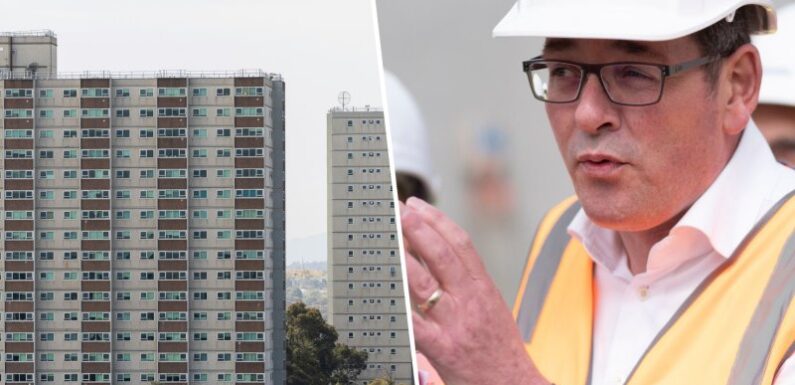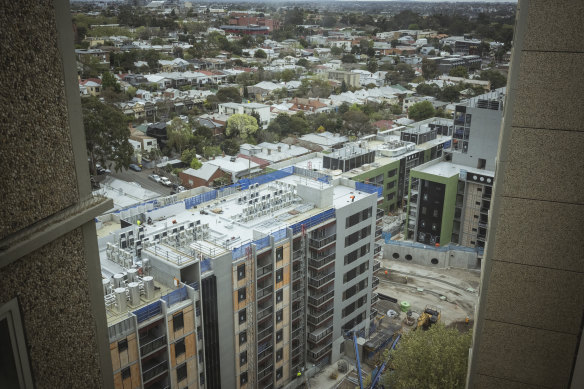
Save articles for later
Add articles to your saved list and come back to them any time.
Melbourne’s leading planning academics have slammed the government’s plan to demolish and rebuild public housing towers across Melbourne, releasing a joint paper which warns that dislocating low-income communities was known to cause serious harm and even death.
Premier Daniel Andrews described his government’s plan to remake the state’s 44 high-rise public housing towers as the biggest urban renewal project Australia has ever seen, brushing aside criticism from the Greens, the Council to Homeless Persons and others.
“We can’t search for perfection and then not deliver anything; we’ve got to get on and build more houses,” Andrews said.
Six academics from RMIT’s Centre for Urban Research – Libby Porter, David Kelly, Priya Kunjan, Iris Levin, Kate Shaw and Liam Davies – released a joint paper on Thursday arguing that the government had failed to justify its claim the towers were no longer fit for purpose.
The researchers said the policy would, in the short term, exacerbate the housing crisis.
“Supply is one dimension of many drivers that are creating the housing crisis,” the authors wrote.
“This policy, however, will not realise a net gain supply within the next decade, given the simple fact that hundreds of public housing dwellings will be destroyed before the lengthy rebuild program returns any housing to these sites.
“This is occurring alongside a rapid increase in applicants to the Victorian Housing Register (social housing waitlist), rapid growth in private rental households approaching the specialist homelessness service, rising rents and unaffordability, and decreased funding for crisis services.”
Some residents learned they would be evicted from their homes after being approached by the media on Wednesday, after Andrews announced the decision at a press conference.
Under the plan, 44 towers in some of Melbourne’s most prime postcodes – home to some 10,000 people – will be torn down and replaced over three decades with higher-density developments in a public-private partnership.
Andrews said the new developments will be a mix of public, community and privately owned homes for 30,000 people. At least 10 per cent of the 20,000 new homes would be set aside for social housing (as of June, there were 55,850 people on the state’s social housing waiting list).
Patrick Fensham, principal and partner at SGS Economics and Planning, said a 10 per cent increase in social (public or community) housing across the 44 sites was “not ambitious enough”.
“These are precious sites because they’re state-owned. Finding new sites for social housing is difficult, so these sites need to work harder to grow social housing,” he said.
“We need the share of public housing stock to be significantly increased as a proportion of total dwellings to begin to address the vast need. Sites like these are vital for that to occur.”
The premier argued on Thursday that the towers were no longer fit for purpose, saying it was no longer feasible to upgrade the ageing blocks.
“ Not everybody’s coming back. But there’s more public and social housing as a result of this and, what’s more, it’ll be unrecognisable,” Andrews said.
“It’ll be so much better. It’s not falling down. It’ll be brand new. It’s not [going to be] 50 degrees in summer, and freezing cold in winter. It’s not [going to be] horribly energy inefficient. These are some of the most expensive square metres anywhere in the state, in terms of the running costs.”
Former Liberal premier Jeff Kennett criticised the decision on social media platform X (formerly Twitter), posting: “They are solid buildings, close to all services, and accommodate thousands of families. In fact the govt should build more to meet the immediate needs.”
The view from the old tower at Racecourse road of the under-construction new housing towers.Credit: Chris Hopkins
The first towers to be demolished will be two redbrick towers in Carlton –20 Elgin Street, and 141 Nicholson Street – which are empty and scheduled to be rebuilt by 2028. Two towers in Flemington (120 Racecourse Road, and 12 Holland Court), and one in North Melbourne (33 Alfred Street) are also among the first towers to go.
RMIT sustainability and urban planning lecturer Iris Levin, one of the paper’s authors and who has researched public housing estate renewal projects in Melbourne, said the process as announced would place great strain on the city’s already strained housing market.
“In the midst of a housing crisis they are going to relocate those living in public housing towers, find them other properties to live in, and then demolish the towers, instead of first building new public housing properties?”
Levin researched the fate of residents relocated from the Carlton walk-up flats, which were redeveloped from public housing to a mix of private and public housing between 2006 and 2011.
“Because it took five years [to rebuild], 80 per cent didn’t come back … it’s a long process.”
Housing expert Dr Katrina Raynor, principal social consultant at Umwelt Environmental & Social Consultants, said Housing Victoria’s task of relocating public housing residents must be undertaken with great care.
“These towers are incredibly tight-knit communities in ways that private high-density buildings are not,” she said.
“They’re really tight-knit and the demolition of buildings has to be done very, very carefully, or you demolish incredibly important ecosystems and social connections.”
with Rachael Dexter
Get the day’s breaking news, entertainment ideas and a long read to enjoy. Sign up to receive our Evening Edition newsletter here.
Most Viewed in Politics
From our partners
Source: Read Full Article
